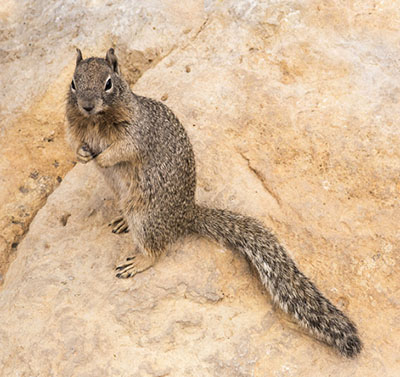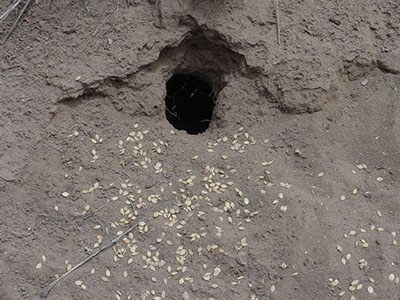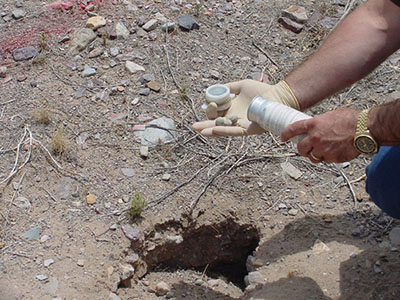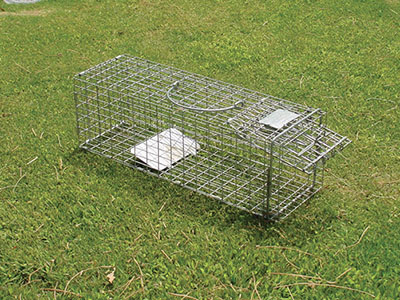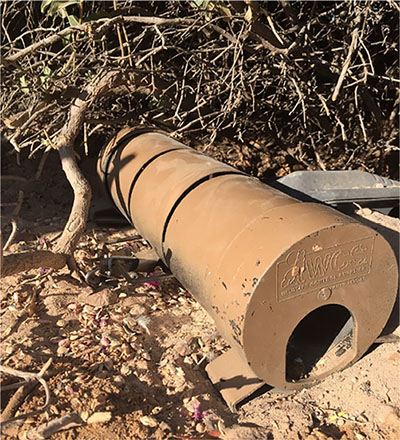Circular 574
Revised by Samuel T. Smallidge
College of Agricultural, Consumer and Environmental Sciences, New Mexico State University
Author: Extension Wildlife Specialist, Department of Extension Animal Sciences and Natural Resources, New Mexico State University. (Print Friendly PDF)
Introduction
Rock squirrels are burrowing rodents found commonly throughout much of New Mexico. Rock squirrels’ feeding and burrowing habits can create considerable problems for humans. They may damage cropland by digging up recently planted seeds and eating newly sprouted plants. The squirrels’ tunnel systems may create unwanted diversions and losses of valuable irrigation water. Rock squirrels have been known to pose problems around the house by feeding on flowers and vegetables planted by hard-working gardeners. Burrowing by rock squirrels on playgrounds and parks can also create significant problems for groundskeepers charged with maintenance responsibilities. Therefore, it often becomes necessary to reduce or eliminate the problems associated with these animals.
Identification And Distribution
The rock squirrel (Otospermophilus variegatus) is a relatively large, heavy-bodied ground squirrel with a moderately long, bushy tail (Figure 1). The head and body are about 10.5 inches long and the tail is approximately 8 inches. The squirrels have relatively large ears that extend above the tops of their heads. Their fur is usually brownish gray and mottled with white spots.
Figure 1. Rock squirrel (Lorrie Tiegs, Dreamstime.com).
Rock squirrels may be confused with prairie dogs because of their large body size. However, there are two distinguishing features of rock squirrels that allow for easy differentiation. The rock squirrel has a much larger tail; prairie dog tails range from 1.5 to 4 inches in length, much shorter than the 8-inch rock squirrel tail. In addition, prairie dogs have small, reduced ears, whereas rock squirrels have fairly large ears that clearly reach beyond the crown of the head.
Rock squirrels occur from Mexico to northern Utah and Colorado. These rodents occupy nearly all of Arizona and New Mexico, with the exception of very high elevations. Rock squirrels live in rocky terrain, such as canyons and hillsides, but are also well-adapted to suburban and urban environments.
Seeds, nuts, and berries are important food items for rock squirrels, and their diet can be very diverse. They will feed on acorns, pine nuts, juniper berries, mesquite buds, and fruit from cacti. During the spring and early summer, rock squirrels also feed on green vegetation such as grass, forbs, and flowers.
Rock squirrels dig burrows for shelter from the weather, safety from predators, and food storage. They live in colonies, and several individuals may occupy a single burrow system. Burrow systems are occupied year after year and may be extended in length and complexity annually. Multiple entrances for each burrow system are common (Figure 2).
Figure 2. An entrance to a rock squirrel burrow.
The mating season for rock squirrels occurs between March and July. After a 30-day gestation period, a litter of five to seven pups is born. The pups live in nests constructed of grass within the burrow systems. Rock squirrels are fairly long-lived, with a lifespan of up to four or five years.
Damage Prevention And Control Methods
The rock squirrel is not a protected species in New Mexico. A number of different methods can be used to control them and minimize damage. Where rock squirrel populations are high, several control methods may need to be used simultaneously. Repeated control efforts may be required over the long run to prevent a reinfestation from surrounding areas where rock squirrel control is not practiced.
Habitat Modification
Flood irrigation, as opposed to sprinkler or drip irrigation, may discourage rock squirrels in orchards and alfalfa fields. However, this practice will not remove them completely. Rock squirrel populations can be reduced in crop fields by frequent tillage, especially deep disking or plowing. However, squirrels may move to the margins of the field and feed inward from the borders. It is difficult to remove all possible cover that is advantageous to rock squirrels because they are highly adaptable. However, eliminating or reducing areas of possible escape cover by removing abandoned irrigation pipes, rubbish heaps, and rock piles will limit areas available for establishing burrow systems.
Exclusion
Sometimes it may be possible to exclude rock squirrels from gardens or flowerbeds by using fencing. This is only practical for small areas because of the cost associated with this control method. A 4-foot fence constructed of small wire mesh with a sheet metal band at the top may help exclude rock squirrels. Because rock squirrels are good climbers, a sheet metal band 16 to 20 inches wide should be firmly affixed to the wire at the fence top to prevent squirrels from climbing over. The fence should be buried and flared outward at the bottom to prevent squirrels from digging under the fence.
To prevent the loss of fruit or nut crops, sheet metal cylinders placed around tree trunks may prove effective. The cylinders should be 4 feet high and wrapped around the tree base to prevent squirrels from climbing the tree.
Deterrents
Rock squirrels cannot be frightened from their burrow sites by propane exploders or flagging. Chemical taste and/or odor repellents are ineffective at causing squirrels to leave or avoid an area.
Toxicants
Rodenticide-treated baits may be an economical control method for some circumstances. However, extreme caution must be used when applying toxic baits of any kind in order to avoid accidental poisoning of applicators or non-target animals. It is essential to follow the label exactly, as well as ensure the rodenticide is labeled for use on rock squirrels. Contact the New Mexico Department of Agriculture (NMDA) at 575-646-3007 for any questions about the labeling of specific rodenticides.
Grain treated with zinc phosphide is available as a “ready-to-use” bait. Zinc phosphide is a restricted-use pesticide and can be used only by licensed pest control operators or people who have private applicator licenses from NMDA.
Because zinc phosphide is not highly palatable to squirrels, its effectiveness is improved with pre-baiting. Follow instructions for pre-baiting as detailed on the label. Apply bait treated with zinc phosphide only if the untreated bait is being readily consumed, which may take several days. If the untreated bait is not consumed, then zinc phosphide application should be delayed. Apply bait in a manner consistent with the label. Excess bait that is not eaten by rock squirrels can be a hazard to non-target wildlife or livestock. It is best to remove livestock—especially horses, sheep, or goats—from the pasture before applying bait. For best results, apply the toxic bait early in the day and restrict any human disturbance for several days.
Anticoagulant baits, such as diphacinone and chlorophacinone, are more expensive to use and may require more bait. Anticoagulant baits are not acute poisons and require multiple feedings to be effective. Anticoagulant baits may be applied by hand or used in approved tamper-resistant bait stations. An aversion to the bait is possible if the amount consumed is only enough to make the squirrel ill but not adequate to be lethal.
Fumigants
Fumigating burrows can be an effective technique for controlling rock squirrels. Care must be exercised with all fumigants to avoid exposing anyone to toxic gases. Therefore, do not fumigate burrows near human dwellings because the fumes may seep into the buildings and create a significant health hazard.
Gas cartridges are relatively easy to use and are available commercially. They consist of cylinders of combustible ingredients equipped with a fuse. To fumigate a burrow, light the cartridge and wait for it to begin burning fully before placing it as far back in the burrow as possible. Take care not to extinguish the cartridge on the burrow wall or by burying it in loose soil. After placing the cartridge, place a wad of newspaper in the burrow; alternatively, push a square of felt-tar paper into the hole. Quickly cover the burrow entrances with soil or sod and tamp it tight to seal in the toxic gases. The plug prevents soil from covering the burning cartridge, ensuring optimal function. Fumigation is most effective during early spring before the squirrels have time to reproduce. Wear a long-sleeved shirt and leather gloves to protect yourself from burns.
The method for using aluminum phosphide differs considerably from that for gas cartridges. Aluminum phosphide reacts with moisture to create lethal phosphine gas, so protective gloves must be worn when handling the tablets (Figure 3). Place the prescribed number of aluminum phosphide tablets as far back into the burrow opening as possible. Then insert a wad of crumpled newspaper into the burrow to prevent soil from covering the pellets. Seal the burrow opening tightly with soil. Aluminum phosphide is a restricted-use pesticide, which requires users to be licensed by NMDA.
Soil moisture is important to ensure fumes from fumigants remain concentrated in the tunnels. Additionally, soil moisture influences tunnel humidity, which activates aluminum phosphide.
Note: All label directions for toxic baits or fumigants must be followed exactly in order to be safe and to remain in compliance with federal and state laws.
Figure 3. Wear protective gloves when placing aluminum phosphide tablets into a burrow.
Trapping
Trapping can be effective in removing rock squirrels living in a relatively small area. It can also be an effective control practice in areas where toxic baits or fumigation cannot be used safely. As with all trapping, be sure you are not violating any state or local laws.
Several types of traps are available for squirrels. Standard live traps are the most common type for catching rock squirrels (Figure 4). Live traps are useful under some circumstances where other methods may not be appropriate. Remember to use the proper trap size. The dimensions for live traps are expressed in inches for length, width, and height. The appropriate trap sizes for rock squirrels are 16 × 5 × 5, 19 × 6 × 6, and 24 × 6 × 6. Traps can be set at burrow openings and along trails. When using live traps, make sure they are shaded, and check them frequently to safeguard animals from exposure to high temperatures. In New Mexico, live-trapped squirrels may be dead from exposure by late afternoon during hotter periods of the year. Elevating traps off the ground (e.g., on top of a rock wall) limits potential for non-target capture of some species. Because rock squirrels are active only during daylight, opening live traps at about dawn and closing them at about dusk reduces the chances of catching non-target species such as skunks. Bait traps with pecans, walnuts, almonds, slices of orange or apple, or pieces of melon.
Figure 4. A cage-type live trap for catching rock squirrels.
Squirrels that have been captured in a live trap can be killed in a humane manner through precision shooting. Research by the American Veterinary Medical Association indicates that drowning animals is inhumane. Releasing a rock squirrel unharmed in no way ensures that it will survive, nor is it guaranteed humane. Releasing squirrels into unfamiliar surroundings predisposes them to increased risk of predation, attacks by other squirrels, and exposure to disease, starvation, and dehydration that may result in their death.
Several lethal trap types are available commercially, including WCS tube traps (Figure 5), Koro large rodent traps, and No. 110 or similar-sized body gripping traps. The No. 110 body gripping trap may be placed directly over a burrow opening or placed in a wooden box (Figure 6). The trap box improves the versatility of the trap since it may be placed in known runways or placed near active areas. Furthermore, it is faster to set up because the box eliminates the need to use stakes to stabilize the trap. Securing traps with a tether prevents loss of traps from larger animals. Advantages of lethal traps are that they are designed to kill quickly and remove the need to attend to a live squirrel in a trap. Depending on circumstances and type of trap, using baits may be appropriate. Follow the manufacturer’s instructions for setting, placing, and baiting traps. Be certain not to place lethal traps in areas where pets, non-target wildlife, or children may encounter them.
Figure 5. A lethal tube trap with plastic endcaps installed to reduce risks to non-target animals.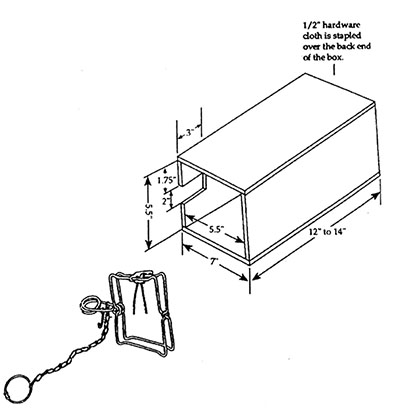
Figure 6. No. 110 body grip trap box diagram.
Other Control Methods
Using a shotgun or rifle may be effective when rock squirrel numbers are low or the removal of a single problem animal is necessary. However, it is illegal to discharge a firearm within city limits and may be illegal in other areas; check with local law enforcement to understand local laws regarding firearm use.
References
Much of the information for this publication was adapted from:
Lee, C., and F.R. Henderson. 1992. Tree squirrels, urban wildlife damage management [Guide L-856]. Manhattan: Kansas State University Cooperative Extension Service.
Marsh, R.E. 1994. Belding’s, California, and rock ground squirrels. In S.E. Hygnstrom, R.M. Timm, and GE. Larson (Eds.), Prevention and control of wildlife damage (pp. B-151–B-158). Lincoln: Great Plains Agricultural Council, University of Nebraska.
Texas Wildlife Damage Management Service. 1998. Wildlife damage management: Controlling ground squirrel damage [Cooperative Extension Service Guide L-1921]. San Antonio: Texas Wildlife Damage Management Service.
For Further Reading
L-210: Rabbits and Their Control in New Mexico
https://pubs.nmsu.edu/_l/L210/index.html
L-211: Controlling Nuisance Woodpeckers in New Mexico
https://pubs.nmsu.edu/_l/L211/index.html
L-212: Controlling Nuisance Birds in New Mexico
https://pubs.nmsu.edu/_l/L212/index.html
Original authors: Jon Boren and Byron Wright, Extension Wildlife Specialists.
Samuel T. Smallidge is the Extension Wildlife Specialist at New Mexico State University. He has degrees in wildlife and range management. His Extension program focuses on wildlife damage management, wildlife enterprises, and wildlife ecology and management education for youth and adults.
Brand names appearing in publications are for product identification purposes only. No endorsement is intended, nor is criticism implied of similar products not mentioned. Persons using such products assume responsibility for their use in accordance with current label directions of the manufacturer.
The pesticide recommendations in this publication are provided only as a guide. The authors and New Mexico State University assume no liability resulting from their use. Please be aware that pesticide labels and registration can change at any time; by law, it is the applicator’s responsibility to use pesticides ONLY according to the directions on the current label. Use pesticides selectively and carefully and follow recommended procedures for the safe storage and disposal of surplus pesticides and containers.
To find more resources for your business, home, or family, visit the College of Agricultural, Consumer and Environmental Sciences on the World Wide Web at pubs.nmsu.edu.
Contents of publications may be freely reproduced for educational purposes. All other rights reserved. For permission to use publications for other purposes, contact pubs@nmsu.edu or the authors listed on the publication.
New Mexico State University is an equal opportunity/affirmative action employer and educator. NMSU and the U.S. Department of Agriculture cooperating.
December 2022 Las Cruces, NM


